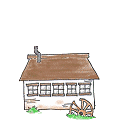Hey Kathleen:
Interesting that you should bring up this project as I am installing a kitchen resource drain project this coming Saturday 11/9 at my house in Phoenix. I intend to blog about the process afterwards and post it on abundantdesert.com. But until then, here’s some info that might help:
--I don’t know what “trailer tongues” are so no help there!
--I know in the city (connected to the main sewer line), we have to install a jandy valve (see pic below) under the sink so we can switch back and forth from sewer (more toxic stuff) to landscape. I’ve had a jandy valve now for a couple of months – I’ve got to say, after YEARS of lugging buckets of water from my sink to the landscape, it is SO WORTH IT!
--since the greywater pipe will not have standing water in it (like pipes bringing water into the house), there shouldn’t be a problem with freezing/bursting. At my house, sink water exits the wall at a height of about 2 ft from the ground. Right now it just spills out into a planting area next to the house. But on Saturday, this pipe will be connected to another pipe that will vent the water into an infiltration chamber 10 ft away near my urban orchard. (see pic below of infiltration chamber pit - the water will come from the brick wall around wher you see the black trashcan. Also silly video below of my dad with the infiltration chamber in the hole). While I’m using an infiltration chamber specifically made for this purpose, you can easily enough get a 55 gallon barrel and saw it in half lengthwise, drill some holes in it and achieve the same thing. Hooking up several half-barrels together to form a long tunnel is more desirable than having just one chamber like I have but my space was extremely limited. Burying the chambers and pipe below the freeze/thaw line would be ideal. For gravity feed, the pipe has to slope 1/4 inch for each liner foot of pipe – so the farther away your infiltration chamber, the potentially deeper it would be buried unless you are at the top of a slope. You can also made the greywater flow through a barrel filled with woodchips first to “strain” it of grease, etc. I am foregoing this step because this trap becomes stinky over time.
--Brad Lancaster, author of “Rainwater Harvesting for Drylands and Beyond” has a font of info on his site. See
this link for resources for parts, etc.






